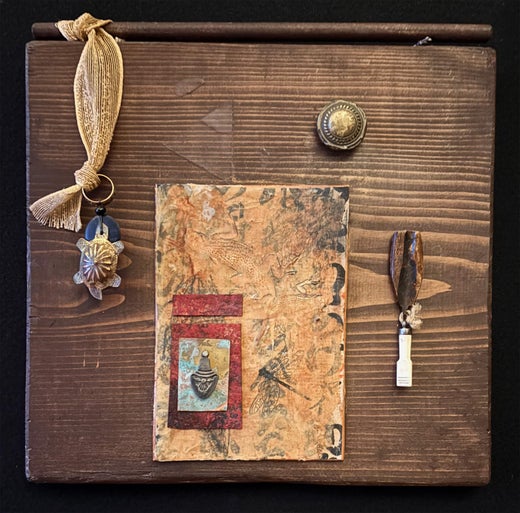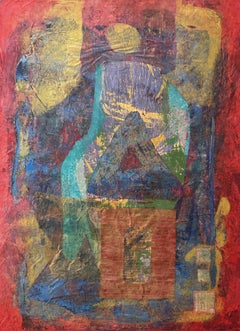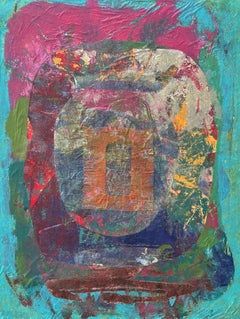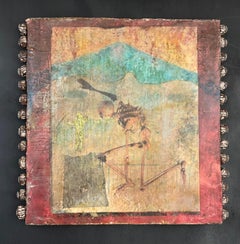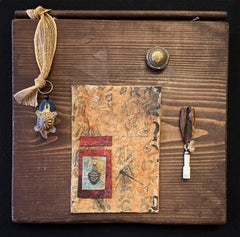Video Loading
Want more images or videos?
Request additional images or videos from the seller
1 of 11
MajioDiptych Playing with Mu2022
2022
$487.50List Price
About the Item
- Creator:Majio (1945, American)
- Creation Year:2022
- Dimensions:Height: 24 in (60.96 cm)Width: 36 in (91.44 cm)
- More Editions & Sizes:nonePrice: $650
- Medium:
- Movement & Style:
- Period:
- Condition:
- Gallery Location:Santa Cruz, CA
- Reference Number:1stDibs: LU2783215469792
Majio has training in the United State, several years in Europe with a Master’s degree from the Buddhist University of Naropa in Creation Spirituality. Her most influential training however was in Japan over a twelve year period. Her initial trip to Japan was to study Buddhist Art, but it quickly narrowed to the traditional arts of Zen and masters if that orientation in other cultural arts. It was not so much what was learned in a papermaking village, kimono dyeing studio or the making, filling and firing woodburning kilns but how to learn or, better said, how to practice. There are many words in Japanese for practice, the one here is the polishing of being. In painting, Majio has always flowed back and forth between figurative and abstract expression. The aesthetics and Cultural Arts--- like calligraphy and tea ceremony---- garnered during her apprenticeships in Japan, along with Zen practices and concepts weave many textures into her work. Majio’s pieces are created with the overarching concept that art is not a polarity between object and subject but rather, complementary, where each part works to define each other. Working from a collaborative process-with materials, with subject and with times, Majio releases herself as sole agent, even when hers are the only hands that touch the piece. This carries out to the viewer, opening a sense of participation, evoking involvement and discussion. Inviting a realization of recognizing and choosing to acknowledge a reality beyond what we have inherited provides a platform for evoking possibilities, innate joy and new vision.
About the Seller
No Reviews Yet
Vetted Professional Seller
Every seller passes strict standards for authenticity and reliability
Established in 1995
1stDibs seller since 2024
5 sales on 1stDibs
Authenticity Guarantee
In the unlikely event there’s an issue with an item’s authenticity, contact us within 1 year for a full refund. DetailsMoney-Back Guarantee
If your item is not as described, is damaged in transit, or does not arrive, contact us within 7 days for a full refund. Details24-Hour Cancellation
You have a 24-hour grace period in which to reconsider your purchase, with no questions asked.Vetted Professional Sellers
Our world-class sellers must adhere to strict standards for service and quality, maintaining the integrity of our listings.Price-Match Guarantee
If you find that a seller listed the same item for a lower price elsewhere, we’ll match it.Trusted Global Delivery
Our best-in-class carrier network provides specialized shipping options worldwide, including custom delivery.You May Also Like
Buick Regal
Located in New Orleans, LA
Charbonnet received an MFA from the University of New Orleans. He has work in the public collections of the Whitney Museum of American Art, the New Orleans Museum of Art, The Speed M...
Category
2010s Abstract Abstract Paintings
Materials
Acrylic, Gouache, Archival Paper, Graphite
Planet Caravan
Located in New Orleans, LA
Charbonnet received an MFA from the University of New Orleans. He has work in the public collections of the Whitney Museum of American Art, the New Orleans Museum of Art, The Speed M...
Category
2010s Abstract Abstract Paintings
Materials
Acrylic, Gouache, Archival Paper, Graphite
Chicot: Approaching Dusk
Located in New Orleans, LA
Charbonnet received an MFA from the University of New Orleans. He has work in the public collections of the Whitney Museum of American Art, the New Orleans Museum of Art, The Speed M...
Category
2010s Abstract Abstract Paintings
Materials
Acrylic, Gouache, Archival Paper, Graphite
Oscilate Wildly
Located in New Orleans, LA
Charbonnet received an MFA from the University of New Orleans. He has work in the public collections of the Whitney Museum of American Art, the New Orleans Museum of Art, The Speed M...
Category
2010s Abstract Abstract Paintings
Materials
Acrylic, Gouache, Archival Paper, Graphite
El Camino De La Roca
Located in New Orleans, LA
Charbonnet received an MFA from the University of New Orleans. He has work in the public collections of the Whitney Museum of American Art, the New Orleans Museum of Art, The Speed M...
Category
2010s Abstract Abstract Paintings
Materials
Acrylic, Gouache, Archival Paper, Graphite
Meditations #5
By Mark Zimmermann
Located in East Quogue, NY
Unique blue/green striped abstract painting. Acrylic and graphite on paper.
Signed on top right by the artist. Offered unframed
Mark Zimmermann's work is based on the fusion of m...
Category
2010s Abstract Abstract Paintings
Materials
Paper, Acrylic, Graphite
Meditations #1
By Mark Zimmermann
Located in East Quogue, NY
Unique blue striped abstract painting. Acrylic and graphite on paper.
Signed on top right by the artist. Offered unframed
Mark Zimmermann's work is based on the fusion of meditat...
Category
2010s Abstract Abstract Paintings
Materials
Acrylic, Graphite, Paper
Meditations #4
By Mark Zimmermann
Located in East Quogue, NY
Unique blue striped abstract painting. Acrylic and graphite on paper.
Signed on top right by the artist. Offered unframed
Mark Zimmermann's work is based on the fusion of meditat...
Category
2010s Abstract Abstract Paintings
Materials
Paper, Acrylic, Graphite
Meditations #2
By Mark Zimmermann
Located in East Quogue, NY
Unique aqua/blue striped abstract painting. Acrylic and graphite on paper.
Signed on top right by the artist. Offered unframed
Mark Zimmermann's work is based on the fusion of me...
Category
2010s Abstract Abstract Paintings
Materials
Paper, Acrylic, Graphite
Lloyd Martin, Grid 15-16, Mixed Media, 2015
By Lloyd Martin
Located in Boston, MA
Artist: Lloyd Martin
Title: Grid 15-16
Size: 30 x 22 inches
Medium: Mixed media, acrylic, pastel, graphite, collage on paper
Year: 2015
Price: 3,500
American artist Lloyd Martin, kn...
Category
2010s Abstract Geometric Abstract Paintings
Materials
Paper, Oil Pastel, Mixed Media, Acrylic, Graphite
More From This Seller
View AllTyme Portal I Cold wax, monoprints, oil stick on canvas
Located in Santa Cruz, CA
Culture through language determines much of how we interact with time. But tyme is animate, it takes awareness to see how it can bind you, inform you or work you---- at the effe...
Category
2010s Abstract Abstract Paintings
Materials
Oil, Monoprint
Tyme Portal II Cold wax, monoprints, oil stick on canvas
Located in Santa Cruz, CA
Tyme is in another arena than time, for you can borrow it, do it, nick it, mark it, lose it, kill it, take it and make it. It has distance and direction, breadth and texture as it be...
Category
2010s Abstract Paintings
Materials
Canvas, Paper, Oil, Monoprint
Medial Woman with Frog
Located in Santa Cruz, CA
Edged with beads the rough wood plank is covered with burlap then plaster to give a leathery look. Encaustic wax layers elements together as the Medial Woman goes about her business....
Category
2010s Folk Art Mixed Media
Materials
Burlap, Plaster, Wood, Paper, Mixed Media, Wax, Acrylic
Artifacts of Various Realities -Tray 4 Found Objects on Wood
Located in Santa Cruz, CA
The Tibetan dorje, a ritual object in Tibetan Buddhism, symbolizes indestructibility and irresistibility while a crow peeking out from behind the Japanese script for hah dominates.
...
Category
2010s Other Art Style Mixed Media
Materials
Metal
Artifacts of Various Realities-Tray 3 Small objects on wood provoking new storie
Located in Santa Cruz, CA
Crows, Red/black Japanese hanafuda gambling card, fertility and silver charms. The worn spot beneath the curved wire asks what’s missing?
The format of our stories are reluctant to ...
Category
2010s Other Art Style Mixed Media
Materials
Silver, Wire
Artifacts of Various Realities -Tray 5 Small objects, wood provoking new stories
Located in Santa Cruz, CA
Less literal than the other trays, Tray #5 presents a brass knob, turtle talesman, trinket of a vessel and an esoteric tool--- implements in a fairytale.
Artifacts of Various Re...
Category
2010s Other Art Style Mixed Media
Materials
Metal
Still Thinking About These?
All Recently ViewedMore Ways To Browse
Marblehead Ma
Mario Gonzalez
Mark Rothko Style
Muzaffar Abdullaev
Neutral Wall Art
Nicolas Poliakoff
Peter Rodulfo
Petra Schott
Smiley Face Art
Stephen Gilbert
The Long Goodbye
Thornton Willis
Tommy Lennartsson
Topaz Painting
Umbrella Abstract Painting
Vakho Bugadze
Yellow Figure Abstract Painting
1930s Abstract Oil Paintings
